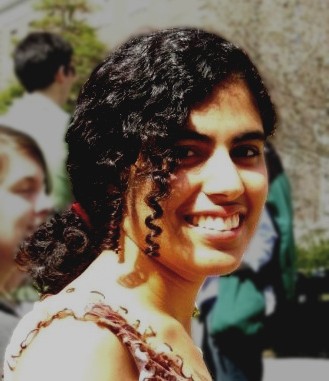This post is written by Holly Capelo who is a master’s student in Astronomy at Wesleyan University and currently studies transition disks in young stellar objects at optical and near-infrared wavelengths. Here she discusses the purpose of a terminal M.A. degree and relays some advice about facing career challenges given by a senior project scientist for the James Webb Space Telescope (JWST) when he recently visited Wesleyan.
In May, Dr. John Mather was seated in the Van Vleck Observatory library of Wesleyan University, lunching with astronomy majors and master’s students. He had been invited to deliver a set of talks about his work in cosmology, and during lunch he asked us questions about life in the department and our favorite authors, while we probed him about his experiences since winning the Nobel Prize in 2006 for discovering the blackbody signature of the cosmic microwave background radiation and its anisotropies. He told us about his experiences at the prize ceremony in Stockholm, but, as befitting the company of aspiring scientists, said much about his early career – with special emphasis on the uncertainties and challenges involved.
“COBE grew out of my Ph.D. thesis, which was a failure, actually”, he said, describing the balloon-borne experiments he had carried out as a graduate student, which were the precursors to the Cosmic Microwave Background Explorer Satellite, of which he was the project scientist and the principal investigator.
“We didn’t expect to win the grant for the satellite. We just kept – not losing – and eventually it was approved.” Even after COBE had been scheduled for launch by NASA, there were delays because another mission had priority.
“During this time, we improved the sensitivity of our detectors. Without those improvements, we might not have been able to detect such minute temperature fluctuations.” He implied that the critical difference in discovering the anisotropies associated with structure formation in the early universe resulted in part from this inadvertent opportunity for upgrades.
With his happy-ending parable, he urged us to recast each impasse or seeming detour as a chance to seek excellence; it was apt advice to us four astronomy master’s students who, finding ourselves in a graduate program, were however not strictly en route to becoming Ph.D. scientists. Indeed many Wesleyan master’s students use the program to increase their level of preparation and competitiveness for future study in doctoral programs.
I mention John Mather not because I presume that all of our stories will culminate in a trip to meet the Queen of Sweden, but because he was very honest about the challenges and diversions that can come up in a science career and the need to be flexible in light of them. In my case, I felt that Wesleyan offered some short term flexibility while increasing my long-term potential. When choosing between the offer from Wesleyan and one from a Ph.D. program, I felt limited because my list did not include schools in Europe, where I have personal ties. I learned that several Wesleyan Master of Arts (M.A.) students had entered foreign doctorate programs, which frequently require a master’s level thesis in their application packages. I might have obtained a master’s degree in the same time by beginning a Ph.D., but if I chose to finish out my doctoral studies in Europe, it could have meant departing early with unfinished business rather than with a self-contained thesis. As noted by others, there are often personal circumstances that can nuance an individual’s choice of school. All things considered, the M.A. program suited me best.
What is the program like?
In general the program is quite flexible: the curriculum includes a baseline number of astronomy courses and the rest of the course work is custom fit for individual students’ backgrounds and goals; often the candidates have undergraduate degrees in related fields, such as math, physics and computer science, and acquire astronomy-specific research and academic experience during their time there. The small department is housed entirely in an antique observatory on a bucolic liberal arts campus. I have found the deliberate manner in which Wesleyan incentivizes excellence in teaching, in addition to research, to make the classroom a very productive learning environment. An R1* school would likely present a wider range of research areas than are currently offered at Wesleyan, but even so I had a hard time narrowing down my thesis project from diverse options. Attending colloquia and lunching with the speakers is a regular activity during the semester in addition to lectures, problem sets, grading and office hours, and – if there’s time – research. Because of this last point, the summer between the first and second year is when students take a written and oral qualifying exam and are expected to commit to a thesis project and make ample progress on it. The second year students typically have more time in their course schedule to devote to their research.
What use is the degree?
As our lunch in the library continued, I became a little tense remembering that I had to complete a computational project that day, but our guest drew me back to the conversation,
“So there must be a wide net of former Wesleyan students, and here we are at a nexus, and someday you will all go your own ways and reach out once in a while. “
It actually had been from former Wesleyan master’s students who went on to doctoral programs at Columbia and Yale (where I had been an undergraduate and research staff, respectively) that I learned about the program. Their examples indicated that a master’s degree can be an effective stepping stone to competitive doctoral programs. Because the program lasts only two years, the turnover in students is high, affording a brief but concentrated chance to form relationships. Since our nexus in the library, the students one year my senior have graduated, one beginning a Ph.D. in Canada, and the other taking a technical assistant position at CfA’s Chandra X-ray Observatory. It is not uncommon for Wesleyan alumni to find long-term positions in science education or as research staff at facilities such as the Space Telescope Science Institute and Chandra, which offer salaries commensurate with a post-graduate education, but for which a Ph.D. might be considered an over-qualification. There are other examples of alumni who have become successful science journalists. All of these career path alternatives deserve consideration in light of the manner in which Ph.D.’s are currently being awarded at a rate that out-paces the number of available post-docs and professorships. The competition for permanent astronomy positions will become ever more fierce if congress goes through with the de-funding of JWST, releasing hundreds of scientists into the job market.
What about the future?
Our speaker’s public talk happened to be on the topic of the long-awaited JWST. The auditorium where it was held quickly became standing room only. I noticed faces from the local gentlemen’s amateur astronomer club that holds events in Wesleyan’s observatory as well as students from the introductory courses I had TA’d. Their faces twitched with recognition of recently-learned concepts while Dr. Mather’s talk strung together his previous achievements in the field of cosmology with the promise of the new space telescope to offer an unprecedented look at the early universe; the wavelength regime of JWST’s instruments will allow us to look at extremely old and distant ultraviolet-bright objects whose light has been cosmologically redshifted into the infrared. At the end there were as many scientific as political questions, like,
“How do you convince congress to fund science?”
To which he responded that it is not legal for NASA employees to try to persuade congress on financial matters, but urged the audience to write congress about why science is important to them (while I am recycling his advice, now is more important than ever to write!).
Despite the challenges facing JWST and the retiring of the other great observatories, it is apparent that the future of astronomy lies in discovering our past: with each technological leap forward we look deeper into our distant cosmic origins. I too may be able to say more about my Wesleyan experience – as it fits into the grand scheme of my career – in a few years, with the benefit of hindsight. It seems though, from my encounters with scientists at all stages, that most people choose this often uncertain path because we share a drive to go on solving interesting problems, receiving knowledge and imparting it to others, contributing to a rapidly progressing field, and seeking a deeper understanding of the universe we inhabit. For now my master’s program is my vehicle to continue these pursuits while being financed to do so. This week’s scare over the de-funding of JWST seemed to awaken career and other anxieties in astronomers of all stations, which reminded me that long-term opportunities in this field can be tenuous no matter what career stage. I had a surprisingly patriotic response to this news, feeling deeply saddened for what the telescope’s demise might mean for the role of America as a technological and intellectual world leader. My discussion here is all about preparing for an astronomy career, but the retiring of major science missions and subsequent cancellations of their successors will give our generation of astronomers less to prepare for. So while I hope for my own longevity in astronomy and will continue to seek out new opportunities, I am pointing my focus towards the exciting day-to-day challenges here at Wesleyan.
Note: I have not provided comprehensive coverage of programs similar to Wesleyan, but please feel free to post comments and info relating to similar opportunities.
* R1 refers to a group of schools classified as “Research Universities I” by the Carnegie Foundation for the Advancement of Teaching. The 1994 definition specifies that these schools offer a full range of baccalaureate programs, are committed to graduate education through the doctorate, give a high priority to research, award 50 or more doctoral degrees every year, and receive $40 million or more each year in federal support.




